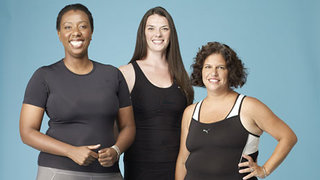Losing the Fat that Lurks Within
That's the fat that's actually inside your body, not just under the skin like subcutaneous fat is. No, the visceral fat is wrapping itself around your liver and other vitals. Not only that, it doesn't just sit there quietly destroying your buff image. Oh no. Those fat cells are veritable factories, gushing bad hormones and spitting out factors that shut down the production of the good ones. Recent studies have implicated excess visceral fat as increasing the risk of heart disease, diabetes, and, possibly, dementia and some types of cancer. Not a pretty thought.
For instance, in a study on 27,000 people in 52 countries, scientists found that the body mass index, a commonly used indicator of obesity which uses a weight to height ratio, wasn't really different in people who had heart attacks compared to those who didn't. But the waist-to-hip circumference ratio, a measurement of visceral fat, was significantly higher in the heart attack victims, regardless of gender or other risk factors.
So what's a good waist to hip ratio? There is some controversy about this, but an often-cited "ideal" value for women is 0.8 or less and 0.95 or less for men. It's like the "apple" or "pear" shape comparisons we've heard about before.
Other studies on show just as chilling results for those high visceral fat with respect to risk for metabolic syndrome, dementia, gallstones, breast cancer in women, and overall death in men.
So there we are. Besides being something we don't like to see in the mirror, this kind of fat is actually dangerous. Fortunately, the doctors say it is also relatively easy to release this kind of fat. Since those fat cells are so metabolically active, it responds to proper diet and exercise, though not to sit-ups and liposuction, natch.
The dietary warning flags go up for saturated fats, the ones that are solid, like butter, lard, and animal fat. I bet you already knew to stay away from those, but now we have another reason.
But one of the best-studied ways to keep visceral fat from increasing with age and to even get it off once it's there is with exercise. Researchers at Duke University Medical Center reported that overweight people in their study would gain about 8.6% in six months, or about 4 more pounds a year, if they didn't exercise, much of it visceral fat, in an article published in the October, 2005, issue of the Journal of Applied Physiology. Duke exercise physiologist Cris Slentz, Ph.D., the lead author, said "We also found that a modest exercise program equivalent to a brisk 30-minute walk six times a week can prevent accumulation of visceral fat, while even more exercise can actually reverse the amount of visceral fat."
The 30 minutes six times a week translates to about 12 miles a week of either brisk walking or jogging. At about 17 miles of jogging or the equivalent on various cardio machines, the amount of visceral fat goes down. The next thing to study is the effect of adding in some resistance or weight training and see if that holds the visceral fat at bay or even makes it go away faster. The people who participated in this study weren't allowed to change their diet so the researchers could study one thing at a time. But that doesn't mean that we can't.
Gotta to go find my tape measure, now. And my pedometer. See you later.
Related Articles
-
Kim Kardashians Wedding Weight Loss Plan:
From various sources, it is reported that Kim Kardashians Wedding
-
Importance of HCG Kent in weight loss program.
Kent HCG diet is increasingly becoming popular these days due to its e
-
A Better Review Of Capsiplex And The Best Way To Lose To Weight
If you ask some people you will get to know that they think weight
-
Body Detox for better Health
Rinse Yourself and improve Body Detox for Wellbeing Theres fastfood
-
Diet Solution Program Ebook
In this day, dieting is not easy and many people choose an extreme met
-
Fat Burning Furnace - An Easy Diet that Takes Little Effort?
Fat Burning Furnace - An Easy Diet that Takes Little Effort? How to L
- DON'T MISS
- Intermittent Fasting - The New Quick Way to Lose Weight!
- Healthy Diets For Weight Loss - Know How
- Learn the Secret to Weight Loss
- A Guide to Cellulite Treatment
- Things that can help you reduce your weight with the help of weight loss plan
- Easy Tips For Shaving Those Dreaded Calories
- The Psychology of Weight Loss: Part 6 - Its Not About Numbers!
- Strip That Fat Review - Does This Diet System Work?
- Diet Pills Can Be Harmful - Try Fat Loss 4 Idiots - Does The Fat Loss 4 Idiots Diet Work?
- Fat Burning Furnace - Short Burst Workouts with Fast Results that Only Take 15 Minutes to Do!




